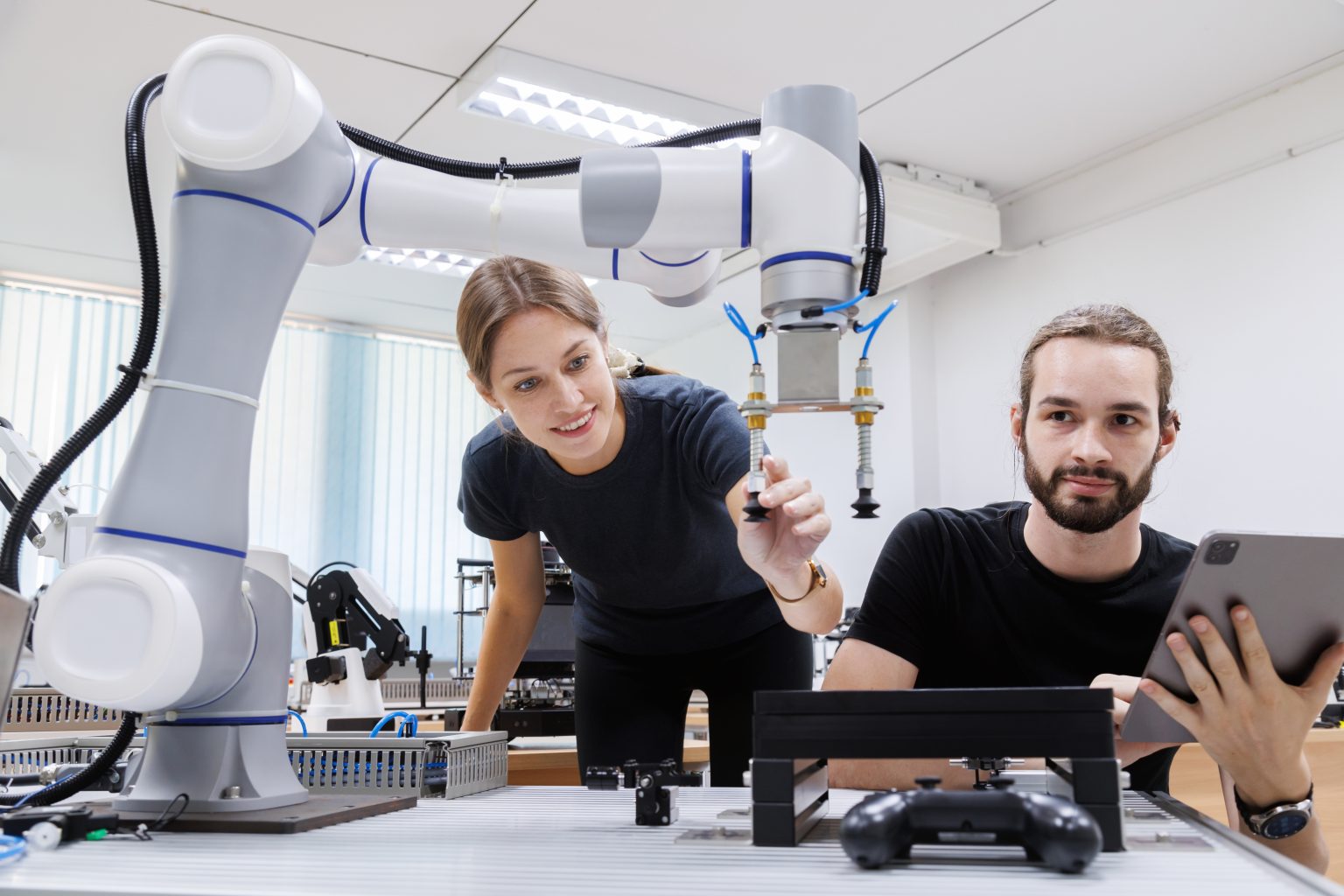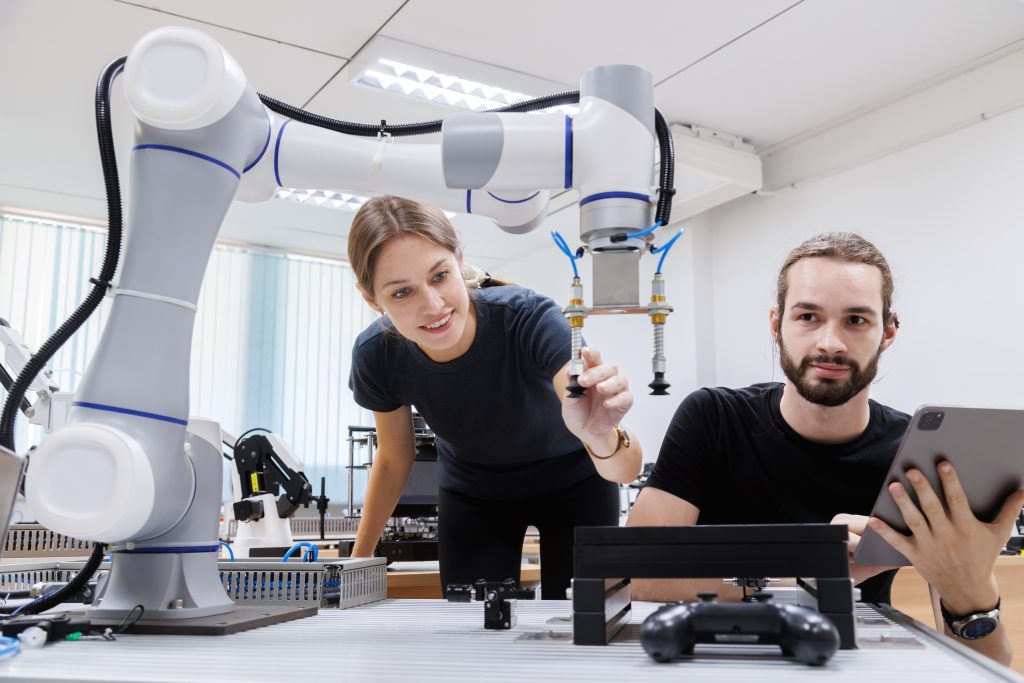What Is Cobot Automation?
Cobot automation puts collaborative robots beside people. Unlike large fenced and traditional industrial machines, cobots are light, rounded, and use force- or vision-sensors to slow or stop on contact. Workers teach them by hand-guiding or simple drag-and-drop software, so new jobs can be set up in a few minutes. The shared workspace empowers humans to handle judgment tasks while the robot lifts or repeats, all within safety regulations such as ISO/TS 15066. To put it in one line, cobot automation cuts strain and speeds production without the fences.
The Growing Adoption of Cobot Automation
Market Outlook
Most 2025 reports put the global collaborative-robot market at about USD 4-4.3 billion. Forecasts are steep: Verified Market Research expects USD 50.76 billion by 2032, while Precedence Research sees USD 71.26 billion by 2034—both implying approximately 32-40% yearly growth. Even the cautious Markets & Markets scenario has sales almost tripling to USD 3.38 billion by 2030. Taken together, cobot automation is moving from niche to mainstream.
Why Companies Are Adding Cobots
Factories cite people first. Chronic labor shortages leave shifts unfilled. Rising wage bills add urgency, as inflation bites. Cobots are small, quick to redeploy, and work without big safety cages, letting lines switch products in minutes. This mix of scarce labor, higher pay, and the need for flexible, scalable gear is why firms of all sizes are turning to cobot automation right now.
Key Industries Leveraging Cobot Automation
- Electronics: PCB makers now bring cobots onto surface mount technology lines to pick, place, and solder parts within 0.1 mm, which helps keep reject rates low. In this space, cobot automation maintains accuracy without tiring human assemblers.
- Automotive: Automobile plants use cobots to load CNC cells, close machine doors, and scan finished parts for scratches or dimensional drift. Their small footprint empowers them to fit between presses and welders without blocking walkways.
- Logistics: Warehouses pair mobile racks with cobots that shuttle cartons, cases, and pallets between pick stations. The cobot automation clears aisles and cuts forklift traffic.
- Food & Beverage: Sanitary-grade cobots place cookies into trays, seal pouches, and even push leaky packs off the belt in wash-down zones. Their FDA-compliant surfaces and quick-swap grippers speed changeovers on mixed product lines.
The Cost of Cobot Automation
Startup Costs
When you price out cobot automation, the robot arm is only the starting line. A contemporary six-axis cobot lists anywhere from about $10k for a hobby-grade unit to $150k for a high-payload model, along with $50-80k common for production-ready arms. Custom grippers, vision cameras, and engineering time to knit the cell into your line add another 20-50% to the bill. Finally, plan a few hundred dollars for virtual safety classes ($315 per person) and around $1,000 for multi-day hands-on programming so operators can keep the cell tuned.
Ongoing Costs
Keeping cobot automation running is modest but not zero. Preventive maintenance—grease, batteries, and the odd belt—runs approximately 10-20% of the purchase price each year, or about $5k–$10k if you need expert technicians. Considerable overhauls only show up after heavy multi-shift use. Vendors also charge $500-$2,000 annually for software licences, cloud updates, and phone support, along with add-ons such as the latest safety zones bumping the tab higher. Energy use is small (a coffee-maker’s draw), and no fence audits mean support time stays low.
ROI Outlook
Because a single cell can replace two manual shifts that cost €80,000 a year, a €60,000 machine-tending setup pays for itself in about nine months. Some high-volume lines—Dynamic Group’s injection-molding plant, for example—report two-month payback once overtime and scrap savings are counted. On the other hand, one full-time U.S. production worker now earns a median $1,194 a week—over $60k a year—so three years of wages exceed $180k before benefits, which is undoubtedly several times the total outlay for cobot automation.
How Cobots Empower Small and Medium Enterprises (SMEs)
Affordable and Easy
A small shop can easily manage entry-level cobots. Usually, SMEs recoup that spend within 12-36 months. Many see full payback in under a year once repetitive work is automated. Drag-and-drop teaching lets staff introduce cobot automation without outside engineers.
Fast to Deploy, No Chaos
Most units bolt to a bench and run after a few hours of setup, not weeks. Atria Scandinavia cut packaging changeovers from six hours to just 20 minutes with three small arms. DCL Logistics kept orders flowing yet still logged a 500% efficiency jump and three-month ROI. This swift roll-out means cobot automation slips into cramped factories without major idle time.
Real-World Wins
Family-run Rousant Sherwood added seven cobots for round-the-clock machine tending and profit. UK maker B-Loony lifted its flag output by 5,000% in nine months after installing six robots. Injection molder AIM Processing quadrupled throughput by roaming one cobot between tasks. So, cobot automation gives small factories big-company efficiency while staying agile.
The Future of Cobot Automation
Collaborative robots are gaining sharper reflexes as onboard AI watches every frame and tweaks motion on the fly. Secure cloud links now let engineers spot faults and patch code without leaving home. Hospitals, farms, and stores are leaning on such machines to fetch supplies, weed rows, and scan shelves. Analysts see the market flying, so the experiments have only begun.
- Real-time Learning: AI models running on the arm or an edge box let a cobot automation cell tune its grip, speed, and path in milliseconds when it meets something new. Surely, that cut in re-programming keeps small batches flowing.
- Cloud Visibility: Cloud dashboards stream sensor data so faults pop up before a line stops. Vendors can even let you tweak code or restart tasks from a browser.
- New Frontiers: In healthcare, cobots fetch drugs and guide delicate procedures under human eyes. Farm units seed and weed all day, while retail bots audit shelves after hours.
Visit our website today and discover how Techman Robot’s collaborative robots can streamline your manufacturing and keep you competitive and future-ready through smart cobot automation.


